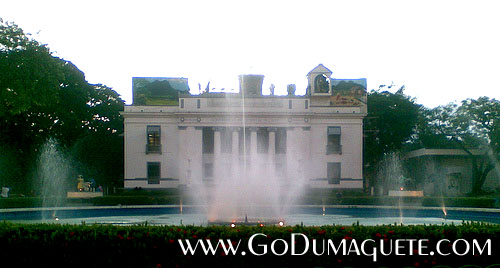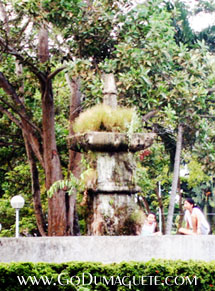

Take a virtual tour of the historical attractions of Dumaguete City & Negros Oriental in the Philippines!
Historical Attractions of Negros Oriental, Philippines
The history of Negros Oriental is one of the longest in the Philippines, dating back to Spanish expeditions after Ferdinand Magellan landed his fleet on the neighboring island of Cebu.
It was not long after that the island was 'discovered' by one of the ships in Magellan's fleet. They encountered the dark-skinned inhabitants of the island whom they called the Negritos, after whom the island was named: Negros.
In Negros Oriental one will find many buildings dating from the Spanish Occupation of the Philippines, while Dumaguete City itself is an architectural relic, like Baguio City in Northern Luzon, of the American occupation of the Philippines in the early 20th century.
SILLIMAN UNIVERSITY
Visitors can pass through the portals of the first Protestant university of the Philippines and tour its 35 hectare campus, with old buildings and modern labs.
Balatong Point
Basay
Also called Punta Tambungon by the locals, with rocks and large corals used as navigation landmarks. The biggest shipment of WWII ammunition for the Negros guerilla movement is said to have been unloaded here, now the favored divesite of many scuba enthusiasts.
Baldwin Locomotive
The Baldwin Locomotive, a popular subject of photographs, rests on memories of its heyday as the dean of the hacienda workhorses. It was integral in stimulating the growth of Negros Oriental sugar industry.
Cata-al Memorabilia
Relics of the WWII encounter in Negros Oriental include American and Japanese materials and personal effects, preserved as part of the personal collection of the Cata-al family in Valencia
Central Azucarera de Bais
Established in 1918 by the Compania General de Tabacos de Filipinas SA, or Tabacalera, as its first sugar mill in the Philippines. Central Azucarera de Bais (CAB) stimulated the growth of the sugar industry of Negros Oriental.
In 1941, the first integrated pulp and per factory in the world was set up at CAB by the Compania Cellulosa de Filipinas, using the bagasse as raw and primary material in the manufacture of paper.
Dumaguete City Hall
Built in 1907, it houses the offices of the mayor, vice mayor, Sangguniang Panglunsod and its session hall and various other government units. Renovation has expanded its spaces and added a new and striking façade. Fronting the old main entrance is Quezon Park that features monuments and a newly expanded children’s playground.
Fil-Am Jap Amity Shrine
At the Sagbang hilltop, a three-sided pillar soars above a viewing deck where Filipino and American soldiers clashed with the Japanese soldiers forces in a fierce encounter during WWII.
Unveiled on April 2, 1977 by veterans and descendants of the war casualties, the shrine overlooks the panoramic sprawl of Dumaguete City, Sibulan and Bacong towns and the neighboring islands of Cebu and Siquijor.
Looc Memorial Shrine
Sibulan
The Looc Memorial shrine marks the site of the first encounter of WWII in Negros Oriental on October 11, 1942 when independent partisan guerilla groups joined forces. The Sibulan municipal government commemorates this event yearly with a re-enactment.
RELATED ARTICLES:
SPONSORED LINKS


Copyright © 2009. All Rights Reserved. Go Dumaguete! Your Gateway to Negros Oriental, Philippines
Provincial Capitol of Negros Oriental Dumaguete City
Constructed in 1924 and inaugurated by Governor Enrique Villanueva on 25 February 1925, the edifice is Grecian in character defined by Ionic columns.
The first provincial governor center was an old residence near the Dumaguete waterfront.
The present capitol houses the offices of the governor, vice-governor, the Sangguniang Panlalawigan, session hall and other important departments. This imposing façade faces Aquino Freedom Park , a formal garden with promenades shaded by old trees, with a musical fountain and a stage for live outdoor performances.
Saint Paul College Dumaguete
Established in 1904 and known as the first St. Paul de Chartres institution in the Philippines. A marker on Rizal Boulevard commemorates the landing of the seven Belgian nuns who founded the school in the old parish convent beside the Cathedral.
Silliman University
Founded in 1901, its 35 hectare campus is adjacent to downtown Dumaguete. Declared a bird sanctuary and noted for its century-old trees, cottage residences and major buildings such as Guy Hall, Channon Hall, Oriental and Occidental Halls which Japanese occupation forces used for administrative and penal activities during WWII.
Silliman Hall
Originally a New York USA theater building, reassembled in Dumaguete City in 1903 to cradle the fledgling Silliman Institute founded in 1901, the first Protestant university in the Philipines. The structure is architecturally distinctive as early Americana.
It now houses the Assembly Hall on the ground floor and the Silliman University Ethno-Anthro Museum on the second floor.
Spanish Fortress
Ayungon
Visit the remains of a Spanish fortification on the shoreline of Tampocon II.
Spanish Fountain
Devised by an Agustinian friar to spout water channeled from a highland spring the fountain, a relic of the town’s colorful historical past, it is now the centerpiece of the distinctive “sunken” Valencia Municipal plaza.




